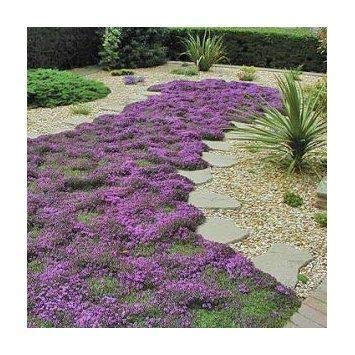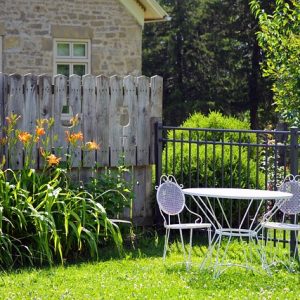Red creeping thyme is a perennial herbaceous plant that tolerates dryness and enjoys the sun. Although it has a delicate appearance, creeping thyme is tolerant of modest foot activity and adapts well to various well-draining settings, making it a low-maintenance plant. Red creeping thyme lawn stays evergreen in milder climates, and the leaves become bronze in the fall.
Learn how to cultivate and enjoy red creeping thyme plants in your environment by diving in. Once you become familiar with this adaptable plant’s startling beauty and adaptability, there’s little question that you’ll keep it in your back pocket, as creeping thyme is a great grass substitute.
CREEPING THYME LAWN
An ideal replacement for standard grass is a creeping thyme lawn. Grass lawns can be replaced with low-growing creeping thyme, which is simpler to manage and uses less water. Additionally, creeping thyme may convert your yard into something entirely different every summer by covering it with a carpet of pink, purple, or red blossoms. Additionally, unlike regular turfgrass, a creeping thyme lawn thrives in direct sunlight and is less susceptible to sunburn. The tiny leaves create a lovely scent. It gives a breeze of freshness in the air. It’s simple to cultivate and develop creeping thyme. There will be bare spots when it is first planted. However, the plant will gradually cover the holes as it develops.
One of the various plants that may be used in place of grass is creeping thyme. The growing creeping plant swiftly colonizes the soil, and its evergreen leaves remain green all year. Creeping thyme is a well-liked plant to grow in place of conventional lawn grasses since it is perfect for xeriscaping.

CREEPING THYME COLORS
Thyme comes in various kinds that you may use in place of grass. The most common ones are red, pink, and purple. Each color holds its significance. The fine-textured leaves of creeping thyme cover a large area of the ground and produce blooms that vary in color according to the variety. In late spring to early summer, the vines start to bloom.
Also Read: 6 Contemporary Twin Bed Frame With Storage Guide for Kids And Adults
Pink blooms are produced by creeping lemon thyme, caraway thyme, and spicy orange thyme, and the plant grows to a maximum height of 4 inches while remaining short. Both pink and red creeping thymes remain small, growing to a maximum height of 4 inches. Woolly thyme may reach a height of 6 inches, although it spreads and grows slowly.
RED AND PURPLE CREEPING THYME
RED CREEPING THYME:
As its name implies, one of the most common types of creeping thyme develops into lovely red blossoms and is utilized as a groundcover. The stem develops horizontally rather than “creeping” and spreading, which is quite interesting. Once the stem contacts the soil, new roots begin forming.
They have small, round, evergreen, or semi-evergreen leaves all over them. Additionally, the mass blooming of the small pink tubular blooms produces a sea of scarlet hues.
PURPLE CREEPING THYME:
A lovely carpet of glossy, dark green foliage and fragrant purple blooms makes up a purple creeping thyme lawn. This ground cover plant has tiny, lovely star-shaped flowers that are purple. Purple creeping thyme makes a fragrant lawn that smells minty as you walk on it. Like most creeping thyme species, this rapidly expanding ground cover plant is 2 to 3 inches tall and spreads by enclosing stems.
Creeping thyme benefits from lots of sunshine and good drainage, like other forms. Imagine stepping on a lovely purple carpet of blossoms that smells good and is covered with blooms.
PROS AND CONS OF CREEPING THYME LAWN
Once they develop, they move quickly and cover the ground like green mats with beautiful blossoms in white, pink, purple, or rose red. However, creeping thyme lawn pros and cons are much like any other plant used as ground cover.
PROS OF CREEPING THYME
- SUITABLE FOR ALL WEATHER: The grass stays green all summer with spreading creeping thyme. It doesn’t require much water to live. The plant is hardy and survives the winter in good health. It is resistant to dampness and frost.
- EASY MAINTENANCE: The plants only grow as tall as two to four inches. It is not essential to trim. Without worrying about your lawn turning into a miniature forest, you may keep them for years.
- HELPS IN POLLINATION: Your lawn’s blossoms attract bees, which aid in the pollination process. You’ll see that if you have other plants next to the grass, they may quickly produce flowers and fruits flowers and fruits with ease. This is because to the fact that bees pollinate them.
- PRODUCE A PLEASANT AROMA: Most artificial grass and turf lawn varieties can produce foul odors. They require frequent washing. Although creepy, thyme produces fragrances just like flowers or herbs.
CONS OF CREEPING THYME
- ATTRACTS HARMFUL INSECTS: Thyme is not well recognized as one of the plants that may fend off bees, aphids, spider mites, and other potentially hazardous insects. Insect repellant is necessary to maintain the health of the creeping thyme.
- IT’S EXPENSIVE: The cost is the most significant disadvantage of installing a creeping thyme lawn as opposed to regular turfgrass. It may cost more to purchase thyme seedlings than to sow grass seeds. Additionally, thyme seed is difficult to germinate.
- DOESN’T THRIVE IN SHADY AREAS: If your yard is shaded, it is impossible to grow a creeping thyme lawn. Creeping thyme struggles even in light shade. Instead, the plant on its woody stalks becomes slim and sparse.
CONCLUSION:
A lawn with red creeping thyme is preferable to one with grass. Red creeping thyme emits a fragrance surge, unlike grass, which can have a disagreeable smell. If your grass is covered with red creeping thyme, one benefit is that you do not need to wash it regularly.
Also Read: Top 5 Home Theatre Power Managers
Watering grass is especially important in dry and hot months. Even with less water, red creeping thyme may survive. Grass has no therapeutic use, but red creeping thyme has. Thyme can be consumed by humans and animals, whereas grass cannot.
So why not choose a creeping thyme yard if you think it’s time to modify the ground cover of your lawn? You can have a single color for your grass or many other hues.




